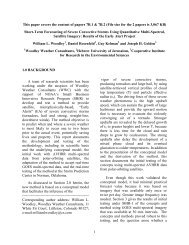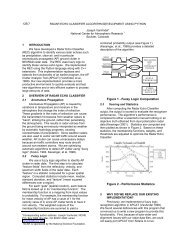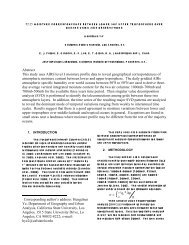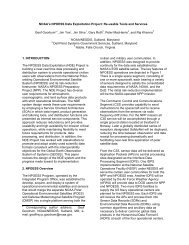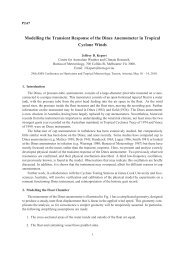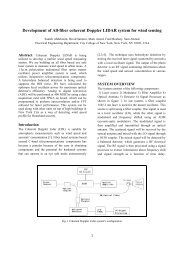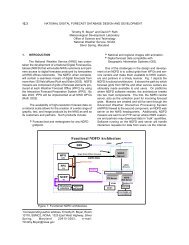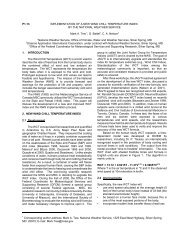1. Introduction 2. RETRO - AMS supported meetings
1. Introduction 2. RETRO - AMS supported meetings
1. Introduction 2. RETRO - AMS supported meetings
You also want an ePaper? Increase the reach of your titles
YUMPU automatically turns print PDFs into web optimized ePapers that Google loves.
Now the key is to determine the complex<br />
weighting function wj. A relatively simple and<br />
robust method developed by Capon (1969) was<br />
successfully applied to atmospheric radar to improve<br />
angular resolution using signals from spatially<br />
spaced receivers (Palmer et al. 1998; Yu et al.<br />
2000), and to obtain high-resolution vertical profile<br />
of reflectivity and three-dimensional wind field<br />
using shifted frequencies (Palmer et al. 1999; Yu<br />
and Brown 2004). Using Capon’s approach, the<br />
weighting vector in <strong>RETRO</strong> can be obtained by<br />
solving the following constrained optimization.<br />
min RYj<br />
wj<br />
(0), subject to qHj wj = 1 (3)<br />
where qj is a column vector of size L specifying<br />
the weights for the true high resolution signals at<br />
the jth subvolume to produce oversampled signals<br />
in V. The optimization ensures that the effect of<br />
interference is minimized while the response of the<br />
weighting function at the jth subvolume is unity. Interference<br />
refers to signals from subvolumes other<br />
than the subvolume in which the <strong>RETRO</strong> estimation<br />
is performed. The Capon weighting vector can<br />
be derived using a Lagrange method (Capon 1969;<br />
Palmer et al. 1998; Yu et al. 2005). As a result, time<br />
series of high-resolution signals at a subvolume<br />
Yj can be generated by substituting the weighting<br />
function into (1). Reflectivity and radial velocity<br />
at subvolumes can be estimated by processing<br />
Yj(mTs), m = 0, 1, . . . M − 1,using either spectral<br />
technique or autocovariance methods (Doviak and<br />
Zrnić (1993), Chapter 6), where Ts is the pulse repetition<br />
time and M is the number of samples.<br />
Yu et al. (2005) have shown that the estimated<br />
high-resolution signal power ( ˆ Pj) is a weighted<br />
sum of the true high-resolution power σ2 l at 2L − 1<br />
subvolumes.<br />
ˆPj =<br />
2L−1 �<br />
l=1<br />
Ejlσ 2 l<br />
(4)<br />
where the weight Ejl is the lth element of square<br />
of the <strong>RETRO</strong> response of the weighting function<br />
Ej, and j = 1, . . . 2L − <strong>1.</strong> Thus, performance<br />
of high-resolution power estimate is determined by<br />
the weighting function which is adaptive to the atmospheric<br />
structure. Note that a deterministic bias<br />
in <strong>RETRO</strong> power estimate will be obtained for the<br />
case of uniform reflectivity. For example, the theoretical<br />
bias for L = 10 is approximately 7.4 dB<br />
given that the correlation of oversampled signals<br />
in range has a triangular shape (Torres and Zrnić<br />
2003). Nevertheless, for the case of uniform reflectivity<br />
resolution is not of primary interest and<br />
the whitening-based technique may be used to improve<br />
the statistical accuracy of the estimates. Yu<br />
2<br />
(a) Signal power and velocity from conventional<br />
sampling<br />
y−direction (km)<br />
5.4<br />
5.2<br />
5<br />
4.8<br />
4.6<br />
−0.5 0<br />
x−direction (km)<br />
0.5<br />
S (dB)<br />
0 20 40 60<br />
y−direction (km)<br />
5.4<br />
5.2<br />
5<br />
4.8<br />
4.6<br />
−0.5 0<br />
x−direction (km)<br />
0.5<br />
V (ms −1 )<br />
−20 0 20<br />
(b) Signal power and velocity from <strong>RETRO</strong><br />
y−direction (km)<br />
5.4<br />
5.2<br />
5<br />
4.8<br />
4.6<br />
−0.5 0<br />
x−direction (km)<br />
0.5<br />
Z (dB)<br />
0 20 40 60<br />
y−direction (km)<br />
5.4<br />
5.2<br />
5<br />
4.8<br />
4.6<br />
−0.5 0<br />
x−direction (km)<br />
0.5<br />
V (ms −1 )<br />
−40 −20 0 20 40<br />
Figure 1: Reflectivity and velocity fields of a tornado<br />
vortex observed by a virtual WSR-88D using<br />
(a) conventional sampling (L = 1) and (b) <strong>RETRO</strong><br />
(L = 5).<br />
et al. (2005) have further shown that the highresolution<br />
<strong>RETRO</strong> velocity is a biased estimator<br />
except for the case of uniform velocity field. However,<br />
the bias can be significantly small such that<br />
the <strong>RETRO</strong> high-resolution velocity estimates still<br />
reflects the true velocity field.<br />
3. Results<br />
<strong>RETRO</strong> is tested and verified using numerical simulation<br />
of a tornado vortex. Oversampled data<br />
were generated based on a simulation scheme<br />
similar to the one used in Torres and Zrnić (2003).<br />
Ideal time series were generated independently at<br />
each subvolume according to designed Doppler



